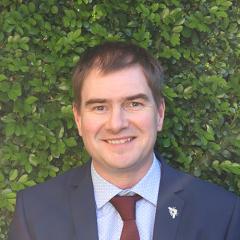Microplastics, which are very small pieces of plastic (<5mm), are formed during the degradation of larger plastic products and are found throughout the oceans. Most plastic pollution is washed into waterways and delivered to the coast by rivers, where it is trapped nearshore in estuaries and coastal ecosystems. While the sight of visible plastic debris on the beach is distressing, the presence and impact of microplastics go largely unnoticed due to their microscopic size. However, the consequences of microplastics in our waterways are far-reaching and profound. These tiny plastic particles can be ingested by microscopic aquatic organisms, leading to disruptions in food chains and starvation within ecosystems. Evidence suggests the environmental fate of microplastics can have negative impacts on invertebrates, including crustaceans and bivalves, reducing survival rate, feeding ability, and immune system function. Moreover, the consumption of microplastics by seafood species poses a direct threat to human health.
Additionally, microplastics can leach harmful chemicals into the environment and attract and concentrate heavy metals and organic pollutants, exacerbating the contamination of marine habitats. Unfortunately, we still know relatively little about the types of microplastics and the extent of their entry into Australia’s coastal oceans via rivers. There is currently limited information on the extent of microplastic pollution in the enclosed Moreton Bay and how it might be impacting the range of marine ecosystems within the Bay. We need to protect the health of our ecosystems, safeguard human well-being, and preserve the natural beauty of this precious marine environment. We, aim to provide a comprehensive assessment of types and concentrations of microplastics in Moreton Bay and we propose to analyse the Brisbane and Logan River waters flowing into the Bay, sediments in mangroves, seagrass, and reef areas (from across the Bay, including Pine and Caboolture Rivers and the Pumicestone Passage; islands including the Moreton, North Stradbroke, and Mud Islands) to understand the distribution and trapping efficiency of different ecosystems, and key marine species important to the local aquaculture industry – to evaluate the exposure and risk to the marine organisms within the bay.
Research Outcomes
Together with collaborators, A/Prof. Helen Bostock (UQ) and Dr. Alistair Grinham (UQ), we have analysed sediment samples from the Bay which shows the presence of seven different plastics. The total plastic concentration varied significantly across the bay, with the highest concentration of plastics found in the Northern Bay, Mangroves, and Seagrass areas and the least amounts of plastics found in the Southern Bay. Using the average concentrations of Microplastic in the samples from the north and the south of the bay and the bulk density of sediments in these regions, along with the volume of sediments in the top 10 cm of the bay, we estimate that the total microplastic budget for Moreton Bay is around 7,000 tonnes. To the best of our knowledge, this is the first study to determine the extent of microplastic pollution in Moreton Bay by providing an assessment of the spatial distribution of plastics, the types of plastic and the preliminary total budget of microplastics in the Bay. With the results from our preliminary study, it is imperative that we develop a comprehensive understanding of the types and distribution of microplastics in Moreton Bay to effectively address this pervasive issue.
We will collaborate, engage, and discuss the findings with First Nations organisation, Quandamooka Yoolooburrabee Aboriginal Corporation (QYAC) and Healthy Land and Water and local regional councils that manage the coastal regions around Moreton Bay. The data will provide a baseline to monitor the plastic and determine if there has been any impact of management controls in the future. The results will be presented at public talks, workshops and conferences and will be published in peer-reviewed journals as well as ‘The Conversation’.
The project will provide the Quandamooka people with data on the plastic pollution within the bay and help to improve understanding of how it might influence the ecosystems and fauna of the bay. This fits within the QYAC research priorities – General: Physical infrastructure study including refuse collection and drainage. This will also contribute to environmental health assessments of Moreton Bay through regional monitoring programs e.g., Ecosystem Health Monitoring Program (Healthy Land and Water) and is of interest to Healthy Land and Water and local regional councils that manage the coastal regions around Moreton Bay.
Oysters and prawns are important seafood items in Australia and key cultural resources for First Nations Peoples. The project will provide data on the plastic pollution in economically important marine organisms of the bay and will be of interest to commercial and recreational fishers who utilise the bay, including OzFish who are currently undertaking the Moreton Bay Shellfish Reef Restoration – Queensland/OzFish Unlimited.
The fellowship has significantly advanced knowledge on plastic pollution in Moreton Bay ecosystems, linking plastic deposition trends with historical events. Partnerships with researchers from the University of Tasmania and UQ have been established through this fellowship to analyses historical sediment samples from the Derwent Estuary Tasmania for microplastics contamination, strengthening the research network and contributing to ongoing environmental studies.
- Historical Deposition of Plastic Pollution in Sediment Cores: Two sediment cores from Moreton Bay were analysed using pressurized liquid extraction and pyrolysis gas chromatography-mass spectrometry (Pyr-GC/MS). The study quantified seven plastic polymers, with a total surface concentration of 8,620 µg/g dry weight, decreasing with depth. No plastics were detected before 1975. Polyethylene was the most abundant polymer. Results indicated that plastic deposition trends align with global plastic production, population growth, and major flooding events. This study was published in ACS EST Water.
- Plastic Pollution in Mangrove Ecosystems: Five sites near the Port of Brisbane were sampled for plastic contamination in water and sediment.
- Microplastic Contamination in Surface Water: Surface water samples from approximately 50 sites across Moreton Bay and the Brisbane River have been collected and processed for Pyr-GC/MS analysis. This study will provide a detailed assessment of microplastic contamination in the region’s aquatic environments.
- Microplastic Contamination in Seafood: Fifteen seafood species from Moreton Bay have been collected and processed for microplastic contamination analysis using Pyr-GC/MS. The findings will enhance understanding of plastic pollution’s impact on marine food webs.
Awards and Prizes
- Dr Elvis Okoffo was awarded the Max Day Environmental Science Fellowship Award by the Australian Academy of Science.
- Dr Elvis Okoffo was awarded a Goodman Foundation Moreton Bay (Quandamooka) Research Award
- Dr Elvis Okoffo was awarded a UQ Research Station New Project Grant Scheme
Media
- UQ researchers recognised for their research on protecting the environment
- Thousands of tonnes of microplastics found in Moreton Bay
- 2024 Interviews with 9 News and 10 News on microplastics found in Moreton Bay
- 2024 Interviewed as a scientific expert on SBS News regarding microplastics in Moreton Bay and other exposure sources, how they are infiltrating our bodies and ways of reducing exposure.
- October 2024, The Conversation article 700 million plastic bottles: we worked out how much microplastic is in Queensland’s Moreton Bay.
Research Outputs
Conference Abstracts
Okoffo, E.D., Tan, E., Grinham, A., Gaddam, S.M.R, Hang Yip, J.Y., Twomey, A.J., Thomas, K.V. & Bostock, H. Plastic pollution in Moreton Bay sediments, Southeast Queensland, Australia, SETAC Australasia 2023, Townsville, Australia, 7-11 August 2023.
Okoffo, E., O’Brien, J., Rauert, C., Ribeiro, F., O’Brien, S., Toapanta, T., Yenney, E., De la Torre, G. & Thomas, K. Quantitative analysis of micro- and nano-plastics in environmental samples by pyrolysis gas chromatography mass spectrometry, International Mass Spectrometry Conference 2024, Melbourne, Australia, 17-23 August 2024.
Okoffo, E., O’Brien, J., Rauert, C. & Thomas, K. Quantitative analysis or micro- and nano-particles in environmental samples by pyrolysis gas chromatography mass spectrometry, 2nd Nano & Microplastics Australian Conference, Adelaide, Australia, 20-21 March 2025.
Invited Presentations
- Rotary Redcliffe Sunrise Inc program on Family Turtle Awareness Day at Queens beach, Scarborough to 100+ people on sources, impacts and solutions regarding microplastics pollution in Moreton Bay (2024).
- UQ, Centre for Marine Science, TalkFest on sources, impacts and solutions regarding microplastics pollution Moreton Bay to 100+ people (2024).


